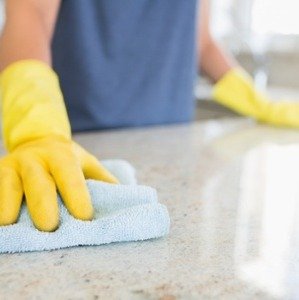How to Remove Hard Water Stains from Granite in 7 Steps

Water contains more than just hydrogen and oxygen molecules. It can also carry a variety of chemicals and minerals, either picked up from the earth during its travels, or added by humans for specific purposes, such as fluoride and chlorine.)
In Rye, NY, and Bethel, CT, water composition typically includes a higher concentration of minerals like calcium and magnesium, common in areas with hard water. These minerals can leave behind deposits on surfaces, including granite countertops, forming stubborn, cloudy stains over time. As water evaporates, mineral residues accumulate, especially on dark granite surfaces, diminishing the stone’s shine. Knowing the local water’s hardness helps residents in these areas select appropriate cleaning methods and products to prevent and remove hard water stains effectively.
Typically, you’d use an acidic substance like vinegar to dissolve the mineral particles, but if you know anything about cleaning granite, you understand that this is a cleaning no-no, as acids can erode the sealant that protects your natural stone surfaces.
How, then, do you go about eliminating the hard water stains marring your gorgeous granite countertops? Here are a few simple steps for how to remove hard water stains from granite and have your countertops sparkling like new in no time.
Step 1: Keep Countertops Clean
The first and best option is to properly clean your granite countertops on a regular basis. Most homeowners wipe up spills daily with a soapy sponge, and this is a great place to start. However, as mentioned, this can leave soap scum behind when you have hard water.
For this reason, you need to follow up with a rinse to remove any traces of soap scum that could dull the surface. After wiping, though, you also need to dry the surface. Remember, standing water can leave mineral deposits behind that are hard to remove, so wipe up spills immediately and dry the surface with a microfiber cloth to soak up all the water and avoid scratching the sealant.
Step 2: Use Stone Cleaner
While mild dish soap and water are certainly safe for your natural countertop surfaces, you’re really much better off skipping the difficulties this combination can cause when paired with hard water and choosing a natural stone cleaner instead. Not only will this specialized solvent keep your finish looking shiny and beautiful, but it helps to preserve your sealant, minimizing the risk of harm to your granite.
Step 3: Treat Water Spots ASAP
As soon as you notice hard water stains, it’s time to treat them. Eliminating dried water spots or rings left behind by wet dishes early on can help to prevent significant buildup that leaves behind hard, scaly deposits.
You may be able to get rid of water stains early on by simply applying a gentle cleanser (natural stone cleaner or dish soap and water) and scrubbing with a sponge or a soft-bristled brush, then rinsing and drying the area thoroughly.
Step 4: Make a Paste
If the hard water buildup on your countertop has solidified into scales, it’s time to roll up your sleeves and use something stronger. While it’s not generally wise to use abrasive cleaners on your natural stone countertops, you can safely treat stubborn hard water stains with a paste of baking soda and water. Simply apply it to the affected area and scrub it with a soft-bristled brush, then rinse with water and dry with a microfiber cloth.
Step 5: Try a Poultice
This old-timey word is often associated with remedies for wounds on the human body, but poultices can refer to any moist, pasty application designed to extract something from a surface when covered and left to work In the case of your countertops, you’ll find that you can purchase granite poultice products from stores that specialize in stone care, or you can simply make your own.
Again, you can make a paste with baking soda and water. For a poultice to work, however, you need to apply it to the affected area, cover it with plastic wrap (you can tape down the edges if needed) and let it sit for 24 hours. Wipe or scrub the poultice away, and reapply as needed to remove hard water stains.
Step 6: Resort to a Razor Blade
This should always be your last resort when it comes to attacking hard water stains, but if you simply can’t scrub them away, a single-edged razor blade could do the trick. You have to be mindful not to cut into the sealant, but when you carefully scrape away at the mineral deposits on your counter surface, you can get rid of them without causing undue harm to your granite.
Step 7: Seal Regularly
An ounce of prevention is worth a pound of cure, and this is especially true when it comes to hard water stains. While maintaining the sealant on your granite won’t actually stop hard water stains, it will help to protect your granite from the lasting harm these mineral deposits can cause, keeping your surfaces shiny and attractive for years to come.
Contact a Local Granite Retailer in NY and CT
Our team provides tips and services to maintain granite in pristine condition. We also specialize in creating custom countertops in Fairfield County, CT and Westchester County, NY and would love to help you select the right surface for your home or project. Please visit us today or contact us here to learn more.


